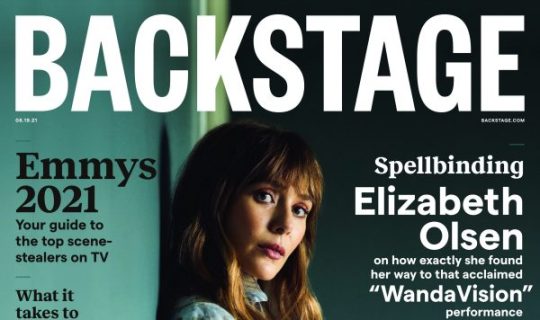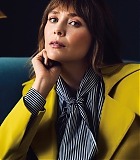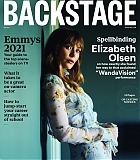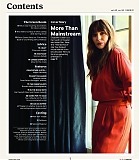#all in all in the long run I do trust Jac Schaeffer
Explore tagged Tumblr posts
Text
Okay, I have some thoughts based on what I’ve been seeing people post.
The first thought is about Rio and Agatha’s kiss. I do not believe that any kiss with Rio would automatically kill Agatha. I do think that Agatha kissed Rio and used that as a way to siphon Rio’s powers (remember, it was established that this would kill Agatha). The visuals in the scene are very much like those they use when Agatha is draining another witch and you can see a brief moment of confusion on Rio’s face when it starts. Agatha’s death is not what Rio expected from the kiss. I think this is also supported by the episode four scene, because there’s no way that either one of them would have been so cavalier about that.
The second thought is about the reasoning behind Agatha killing all those witches. I have two theories on this that I feel very strongly about. It could be one, it could be the other, or it could be a combination of the two. I think that Agatha was killing witches to distract/placate Rio to prevent her from taking Nicky. It’s possible that Agatha thought the deaths could restore a balance and, in a way, pay for her son’s continued life. The other reason could be that Agatha was killing the witches in the hope of gaining enough power to stop Rio from taking Nicky when she did eventually come for him. Either or both could be true (or neither, I just think these are the most plausible reasons).
The third thought is about Agatha and Rio’s relationship as a whole. I see a lot of people posting that they were never in love, that Agatha was only using Rio to delay her own death, but I don’t think that’s the case. The scene at the end of episode four, the way Agatha takes such comfort in Rio, I don’t think that scene would have gone the same way if Agatha didn’t still love Rio, or if Agatha had never loved Rio at all. The way I see it, Agatha made her a promise, “If you do this, I will hate you forever,” and for once in her life, she’s following through. Hate and Love are both passionate emotions, and they turn so easily—but also not at all. If we see more of them, and I am praying to Jac Schaeffer that we do, I think we’ll see that between them. The hate that Agatha feels toward herself for failing Nicky (“The truth is too awful”, “I can’t face him!”) that she’s projected onto Rio for doing the one thing Rio had to do—her job as a keeper of the balance of life and death—and also the love that Agatha had and still has for Rio despite everything.
[Still on that topic, I do think that Rio’s giving Agatha more time was a mistake on her part. Rio thought she was giving Agatha what she wanted, but realistically, I think it ended up hurting Agatha more in the long run.]
The fourth thought is about the posts saying that because the Road wasn’t technically real, Alice’s, Lilia’s, and Sharon’s deaths didn’t mean anything. Just because the physical road they were on was Billy’s creation doesn’t mean it wasn’t real. I’m so confused about why people are saying that. Nothing is real until it’s created. Billy created the Road, and the Road gave them the trials, and in the end they did achieve their goals. Billy’s involvement in the Road’s ‘reality’ doesn’t undo any of that, and I don’t understand why people are saying that it does. I mean, technically, Agatha created the Road and Billy just brought it into existence using his magic. It’s not any less real for that, and their experiences certainly aren’t any less real.
The fifth thought is that we were definitely left with a lot of questions about Agatha. It’s clear that they set some things up with the intention of having those questions answered in later projects (I, personally, am hoping for a prequel or something). How did Agatha get the Darkhold? How did Rio and Agatha meet? What’s the beef between Rio and Agatha’s mother (because there was such tension between them that reeked of history)? Why did Agatha’s mom think Agatha was evil from the moment she left the womb? That’s pretty extreme so there had to be a reason. There’s just so much that wasn’t fleshed out, so I’m hoping they left it in order to have some things to play with later.
If the show had been entirely about Agatha, I think these questions would’ve probably been answered, but it wasn’t and they weren’t. There was a whole coven of witches to go into (and honestly I would’ve loved to see more of them, too). The main point of the show was to introduce Agatha into her role per the comics: a mentor. While the show did that, I think it would’ve benefited from a longer season so that all of the things that got introduced could be fully explored.
#these are all the thoughts I have for now#I haven’t rewatched the episodes yet#instead I had to pretend to be a real person#and go to work in SHAMBLES#all in all in the long run I do trust Jac Schaeffer#and I don’t think that she would’ve introduced these concepts#without the intent to explore them fully later#scottie speaks#agatha all along#agatha all along spoilers#agatha harkness#rio vidal#agathario
26 notes
·
View notes
Text
Press/Gallery: How Elizabeth Olsen Brought Marvel From Mainstream to Prestige
“The thing I love about being an actor is to fully work with someone and try so hard to be at every level with them, chasing whatever it is you need or want from them.”





GALLERY LINKS
Studio Photoshoots > 2021 > Session 008 Magazine Scans > 2021 > Backstage (August 19)
Backstage: Elizabeth Olsen grins widely over video chat when recalling many such moments on set with her co-stars. Yet, she can’t bring herself to divorce such a lofty vision of film acting from the technical multitasking it requires. The camera sees all.
“But then you move your hair, and you’re in your brain, like: OK, remember that! Because I don’t want to edit myself out of a shot. I know some actors are like, ‘Continuity, shmontinuity!’ But the good thing about continuity is, if you remember it, you’re actually providing yourself with more options for the edit.”
That need to balance being both inside the scene and outside of it, fully living it and yet constantly visualizing it on a screen, feels particularly apt in light of Olsen’s most recent project, “WandaVision.”
The mysteries at the heart of the show grow with every episode, each fast-forwarding to a different decade: Could this 1950s, black-and-white, “filmed in front of a studio audience” newlyweds bit be a grief-stricken dream? Might this ’70s spoof be a powerful spell gone awry? Could this meta take on mockumentary comedies be proof that the multiverse is finally coming to the Marvel Cinematic Universe?
The series’ structure, which branches out to include government agents intent on finding out why Westview has seemingly disappeared, calls for the entire cast to play with a mix of genres, balancing a shape-shifting tone that culminates in an epic, MCU-style conclusion. What’s key—and why the show struck a chord with audiences during its nine-episode run—is the miniseries’ commitment to grounding its initial kooky setups and its later special effects-driven spectacle in heartbreaking emotional truths. It’s no small feat, though it’s one that can often be taken for granted.
“I was thinking how hard it would have been to have shot the first ‘Lord of the Rings,’ ” Olsen muses. “Like, you’re putting all these actors [into the frame] later and at all these different levels. All the eyelines are completely unnatural. And yet the performances are fantastic! And technically, they are so hard. People forget sometimes that these things are really technically hard to shoot. And if you are moved by their performance, that took a lot of multitasking.”
As someone who has learned plenty about harnesses, wirework, fight choreography, and green screens (she’s starred in four Marvel movies, including the box office megahit “Avengers: Endgame,” after all), Olsen knows how hard it can be to wrap one’s brain around the work needed to pull off those big, splashy scenes.
“If you think about it, it’s, like, the biggest stakes in the entire world—every time. And that feels silly to act over and over again, especially when people are in silly costumes and the love of your life is purple and sparkly, and every time you kiss them, you have to worry about getting it on your hands. Those things are ridiculous. You feel ridiculous. So there is a part of your brain that has to shovel that away and just look into someone’s eyeballs—and sometimes, they don’t even have eyeballs!”
The ability to spend so much time with Wanda, albeit in the guise of sitcom parodies, was a welcome opportunity for Olsen. Not only did it allow the actor to really wrestle with the traumatic backstory that has long defined the character in the MCU, but having the chance to calibrate a performance that functions on so many different levels was a thrilling challenge.
“It was such an amazing work experience,” she says. “Kathryn [Hahn] uses the word ‘profound’—which is so sweet, because it is Marvel, and people, you know, don’t think of those experiences as profound when they watch them. But it really was such a special crew that [director] Matt Shakman and [creator] Jac Schaeffer created. It was a really healthy working environment.”
Related‘WandaVision’ Star Kathryn Hahn’s Secret to Building a Scene-Stealing Performance ‘WandaVision’ Star Kathryn Hahn’s Secret to Building a Scene-Stealing Performance Considering that the miniseries spans several sitcom iterations, various layers of televisual reality, and a number of character reveals that needed to feel truthful and impactful in equal measure, Shakman’s decision to work closely with his actors ahead of shooting was key.
“We truly had a gorgeous amount of time together before we started filming,” Olsen remembers. “Our goal was—which is controversial in TV land—that if you wanted to change [anything], like dialogue in a scene, you had to give those notes a week before we even got there. Because sometimes you get to set, and someone had a brilliant idea while they were sleeping, and you’re like, ‘We don’t have an hour to talk about this. We have seven pages to shoot.’ And so, we were all on the same page with one another, knowing what we were shooting ahead of time.
“Matt just treated us like a troupe of actors who were about to do some regional theater shit,” she adds with a smile.
That spirit of camaraderie was, not coincidentally, at the heart of Olsen’s breakout project, Sean Durkin’s 2011 indie sensation “Martha Marcy May Marlene.” As an introduction to the process of filmmaking to a young stage-trained actor, Durkin’s quietly devastating drama was a dream—and an invaluable learning opportunity.
“It was truly just a bunch of people who loved the script, who just were doing the work. I didn’t understand lenses, so I just did the same thing all the time. I never knew if the camera would be on me or not. There was just so much purity in that experience, and you only have that once.”
The film announced Olsen as a talent to watch: a keen-eyed performer capable of deploying a stilted physicality and clipped delivery, which she used to conjure up a wounded girl learning how to shake off her time spent in a cult in upstate New York. But Olsen admits that it took her a while to figure out how to navigate her career choices afterward. In the years following “Martha,” she felt compelled to try on everything: a horror flick here, a high-profile remake there, a period piece here, an action movie there. It wasn’t until she starred in neo-Western thriller “Wind River” (alongside fellow Marvel regular Jeremy Renner) and the dark comedy “Ingrid Goes West” (opposite a deliciously deranged Aubrey Plaza) that Olsen found her groove.
“It was at that point, when I was five years into working, where I was like, Ah, I know how I want it. I know what I need from these people—from who’s involved, from producers, from directors, from the character, from the script—in order to trust that it’s going to be a fruitful experience.”
As Olsen looks back on her first decade as a working actor, she points out how far removed she is from that young girl who broke out in “Martha Marcy May Marlene.”
“I feel like a totally different person. I don’t know if everyone who’s in their early 30s feels like their early 20s self is a totally different human. But when I think about that version of myself, it feels like a long time ago; there’s a lot learned in a decade.”
Those early years were marked by a self-effacing humility that often led Olsen to defer to others when it came to key decisions about the characters she was playing. But she now feels emboldened to not only stand up for herself and her choices but for others on her sets as well.
“[Facebook Watch series] ‘Sorry for Your Loss’ I got to produce, and I really found my voice in a collaborative leadership way. And with ‘WandaVision,’ Paul [Bettany] and I really took on that feeling, as well—especially since we were introducing new characters to Marvel and wanted [those actors] to feel protected and helped,” she says. “They could ask questions and make sure they felt like they had all the things they needed because sometimes you don’t even know what you need to ask.”
It’s a lesson she learned working with filmmaker Marc Abraham on the Hank Williams biopic “I Saw the Light,” and she’s carried it with her ever since. “I really want it to feel like we’re all in this together, as a team,” Olsen says. “That was part of ‘Sorry for Your Loss’ and it was part of ‘WandaVision,’ and I hope to continue that kind of energy because those have been some of the healthiest work experiences I’ve had.”
If Olsen sounds particularly zealous about the importance of a comfortable, working set, it is because she’s well aware that therein lies an integral part of the work and the process. As an actor, she wants to feel protected and nurtured by those around her, whether she’s reacting to a telling, quiet line of dialogue about grief or donning her iconic Scarlet Witch outfit during a magic-filled mid-air action sequence.
“Sometimes you’re going to be foolish, you know? And [you need to] feel brave to be foolish. Sometimes people feel embarrassed on set and snap. But if you’re in a place where people feel like they’re allowed to be an idiot,” she says, “you’re going to feel better about being an idiot.”
This story originally appeared in the Aug. 19 issue of Backstage Magazine. Subscribe here.
Press/Gallery: How Elizabeth Olsen Brought Marvel From Mainstream to Prestige was originally published on Elizabeth Olsen Source • Your source for everything Elizabeth Olsen
#Elizabeth Olsen#WandaVision#Avengers#Scarlet Witch#Wanda Maximoff#Sorry For Your Loss#Avengers Infinity War#Avengers Age of Ultron#Captain America Civil War#Ingrid Goes West#Godzilla#Doctor Strange in the Multiverse of Madness#Marvel#MCU#Candy Montgomery#Love and Death#Avengers Endgame
48 notes
·
View notes